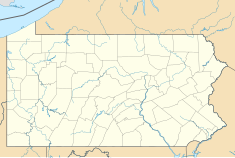Harrison Avenue Bridge
| Harrison Avenue Bridge | |
|---|---|

The Harrison Avenue Bridge in March 2015, with the Central Scranton Expressway under the right-most arch.
|
|
| Carries | Harrison Avenue (State Route 6011) |
| Crosses | Roaring Brook and Central Scranton Expressway |
| Locale | Scranton, Pennsylvania |
| Other name(s) | South-East Scranton Viaduct |
| Maintained by | PennDOT |
| Characteristics | |
| Design | Open-spandrel deck arch |
| Material | Concrete |
| Total length | 407 feet (124 m) |
| Width | 40 feet (12 m) |
| Longest span | 202 feet (62 m) |
| No. of spans | 3 |
| History | |
| Designer | Abraham Burton Cohen |
| Constructed by | Anthracite Bridge Company |
|
Harrison Avenue Bridge
|
|

The Harrison Avenue Bridge in 1999.
|
|
|
Location in Pennsylvania
|
|
| Coordinates | 41°24′00″N 75°39′05″W / 41.400000°N 75.651388°WCoordinates: 41°24′00″N 75°39′05″W / 41.400000°N 75.651388°W |
| Area | less than one acre |
| Built | 1922 |
| MPS | Highway Bridges Owned by the Commonwealth of Pennsylvania, Department of Transportation TR |
| NRHP Reference # | 88000767 |
| Added to NRHP | June 22, 1988 |
Harrison Avenue Bridge is a concrete deck arch bridge carrying Harrison Avenue (unsigned SR 6011) in Scranton, Pennsylvania, United States. Its three spans include an open-spandrel ribbed arch over Roaring Brook, flanked by two closed-spandrel arches. The southwestern closed-spandrel arch spans the former Lackawanna and Wyoming Valley Railroad (Laurel Line), converted to highway use in 1964 as the Central Scranton Expressway. The northeastern closed-spandrel arch spans the former Delaware, Lackawanna and Western Railroad, now a heritage railroad operated by Steamtown National Historic Site.
Built in 1921-1922, the bridge is notable as an example of Progressive Era civic involvement, its construction having been promoted by a citizens' group called the South to East Scranton Bridge Association. It was designed by New York City-based consulting engineer Abraham Burton Cohen, although Scranton Department of Public Works chief engineer William A. Schunk and his assistant Charles F. Schroeder were more actively involved in day-to-day supervision of construction. The bridge was listed on the National Register of Historic Places in 1988.
...
Wikipedia

